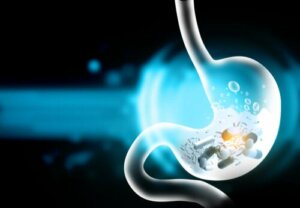9 Medications and Pills for Stomach Pain

There are different medications and pills for stomach pain. These all should be prescribed by your general practitioner or gastrointestinal tract specialist (gastroenterologist).
In fact, there are many possible causes of stomach pain. They include the following:
- Intestinal malabsorption
- Food poisoning
- Intestinal infection
- Intolerance to any food
- Constipation
- Gastroesophageal reflux
- Chronic gastritis
- Inflammatory bowel disease
Bearing this in mind, in order to refer to the different medications and pills for stomach pain, we will use the classification according to their regular use. These are the nine most commonly used groups.
1. Pills for stomach pain: Antispasmodics
Antispasmodics are used for intestinal disorders because they relax the smooth muscle of the stomach, allowing the interruption or prevention of painful and involuntary contraction (spasms). Thus, they’re useful when the pain is of a colic type.
Overall, the best-known antispasmodics are the following:
- Butylscopolamine
- Papaverine hydrochloride
- Pirenzepine
- Trimebutin

2. Anti-inflammatory drugs
Anti-inflammatory drugs inhibit the inflammatory cascade produced by the release of cytokines. They’re indicated when stomach pain is the result of intestinal inflammation, as in the case of inflammatory bowel disease. The most commonly prescribed anti-inflammatory pills for stomach pain are metamizole and mesalazine.
We think you may find this interesting: The Best Natural Remedies for Inflammation
3. Anti-infectives
Anti-infectives are indicated when it’s known that the origin of the gastrointestinal discomfort is due to the presence of an intestinal infection. It may be bacterial, viral, or parasitic. The medication to be used in this case to treat stomach pain will depend on the microorganism in question.
In the case of bacteria, antibiotics are usually indicated. However, when it comes to parasitic infections, antiparasitics are typically prescribed. On the other hand, only general measures to relieve symptoms are usually indicated in viral infections.
The most commonly used antibiotics are ciprofloxacin, doxicillin and metronidazole. Antiparasitics include metronidazole, albendazole, mebendazole, piperazine and nitazoxanide.
Finally, amoxicillin, metronidazole, and clarithromycin are antibiotics used in cases of stomach pain caused by chronic gastritis with suspected or confirmed Helicobacter pylori infection.
4. Pills for stomach pain: Antidiarrheals
Antidiarrheal drugs work like pills for stomach pain by stopping the effects of diarrhea. They inhibit the motility of the intestine, which increases the permanence of feces in the intestinal lumen, favoring its hardening.
They’re not often recommended by doctors, since in case of diarrhea, only general measures are recommended, such as staying hydrated with lots of water, rehydration salts, and home remedies, in addition to an antidiarrheal diet.
However, when a doctor does recommend them, they may recommended one of the following:
- Loperamide
- Bismuth subsalicylate
- Pectin
5. Antiflatulents
Antiflatulents are responsible for inhibiting excess intestinal gas, which is a product of metabolization. Basically, they relieve stomach pain by reducing the accumulation of gas.
- Among them, we find simethicone and dimethicone.
6. Antacids
Antacids improve stomach pain because they work as gastric protectors. There’re inhibitors of acid production, such as pantoprazole, lansoprazole, and omeprazole. Typically, these drugs are used in gastric ulcers, gastroesophageal reflux, and gastritis.
On the other hand, calcium carbonate, sodium bicarbonate, and magnesium hydroxide work as a chemical plug, reducing stomach acidity by neutralizing acids.
Finally, sucralfate or bismuth salts also work as gastric protectors, but by another route. They generate a protective barrier that prevents acid from coming into direct contact with the stomach organ wall.
7. Stimulants for intestinal motility
These pills for stomach pain are used when the origin of the discomfort is constipation, slowing of gastric emptying (feeling of fullness), or is in the presence of reflux and vomiting.
They accelerate gastrointestinal transit so that the contents remain less time in contact with the gastric and intestinal walls. These medications include domperidone, metoclopramide, and cisapride.
You might find this interesting: Ten Healthy Foods to Regulate Your Digestion
8. Pills for stomach pain: Laxatives
Laxatives act in case of stomach pain due to constipation through different mechanisms. There are thickeners or bulk formers, such as Metamucil, which absorb more liquid in the intestines and increase stool volume.
On the other hand, softeners are responsible for lubricating and softening the formed stool to make it easier to evacuate. Meanwhile, osmotic laxatives (such as milk of magnesia, lactulose, or sorbitol) cause fluid retention in the intestines, which makes the stool softer and easier to pass. However, they should be consumed with plenty of water.
Finally, stimulant laxatives (bisacodyl) generate irritation of the intestinal mucosa, with a consequent increase in intestinal transit, thus accelerating stool emptying.
9. Probiotics
Finally, we have probiotics, which in themselves do not have a mechanism to improve stomach pain. However, they’re full of beneficial microorganisms for the intestinal flora.
In the long term, they help regulate intestinal transit and indirectly soothe discomfort related to abdominal pain due to alterations in the microbiota.

Is it always necessary to take medications and pills for stomach pain?
After an evaluation, it must be your doctor who decides which medications are necessary for your stomach pain. In the case of children, the drugs are the same as for adults, but their doses and presentations vary.
On the other hand, the amount of body water in children is lower, so they’re also more prone to dehydration. Because on this, special caution should be taken when dealing with diarrhea in children.
Many times, stomach pain improves when simple, everyday measures are taken. It’s good to opt for a diet free of processed sugars and high-fat foods, in addition to avoiding alcoholic or carbonated beverages like soft drinks.
Finally, if the discomfort is persistent and does not improve with changes in your eating habits, then it’s important that you consult a doctor.
All cited sources were thoroughly reviewed by our team to ensure their quality, reliability, currency, and validity. The bibliography of this article was considered reliable and of academic or scientific accuracy.
- Alrabadi, N., Albustami, I. S., Abuhayyeh, H. A., El-Muwalla, K. M., Alawneh, R. J., Al-Eitan, L. N., … & Haddad, R. (2021). Clavulanic acid in the scope of Helicobacter pylori treatment: a literature review and beyond. Current Reviews in Clinical and Experimental Pharmacology Formerly Current Clinical Pharmacology, 16(2), 128-138. https://www.ingentaconnect.com/content/ben/crcep/2021/00000016/00000002/art00004
- Colín-González, A. L., & Santamaría, A. (2017). Garlic, gastrointestinal protection and oxidative stress. Gastrointestinal Tissue, 275-288. https://www.sciencedirect.com/science/article/abs/pii/B9780128053775000205
- Corsetti, M., Landes, S., & Lange, R. (2021). Bisacodyl: A review of pharmacology and clinical evidence to guide use in clinical practice in patients with constipation. Neurogastroenterology & Motility, 33(10), e14123. https://onlinelibrary.wiley.com/doi/full/10.1111/nmo.14123
- Gordon, M., & Akobeng, A. (2016). Racecadotril for acute diarrhoea in children: systematic review and meta-analyses. Archives of Disease in Childhood, 101(3), 234-240. https://adc.bmj.com/content/101/3/234.abstract
- Khan, A., Alkharfy, K. M., & Gilani, A. H. (2011). Antidiarrheal and antispasmodic activities of Salvia officinalis are mediated through activation of K+ channels. Bangladesh Journal of Pharmacology, 6(2), 111-116. https://ksascholar.dri.sa/en/publications/antidiarrheal-and-antispasmodic-activities-of-salvia-officinalis–4
- Lingala, S., Lau, D. Y., Koh, C., Auh, S., Ghany, M. G., & Hoofnagle, J. H. (2016). Long‐term lamivudine therapy in chronic hepatitis B. Alimentary Pharmacology & Therapeutics, 44(4), 380-389. https://onlinelibrary.wiley.com/doi/full/10.1111/apt.13707
- Mehmood, M. H., Munir, S., Khalid, U. A., Asrar, M., & Gilani, A. H. (2015). Antidiarrhoeal, antisecretory and antispasmodic activities of Matricaria chamomilla are mediated predominantly through K+-channels activation. BMC Complementary and Alternative Medicine, 15, 1-9. https://link.springer.com/article/10.1186/s12906-015-0595-6
- Puoti, M. G., Assa, A., Benninga, M., Broekaert, I. J., Carpi, F. J. M., Saccomani, M. D., … & Borrelli, O. (2023). Drugs in focus: Domperidone. Journal of Pediatric Gastroenterology and Nutrition, 77(2), 13-22. https://journals.lww.com/jpgn/abstract/2023/08000/drugs_in_focus__domperidone.4.aspx
- Safavi, M., Shams-Ardakani, M., & Foroumadi, A. (2015). Medicinal plants in the treatment of Helicobacter pylori infections. Pharmaceutical Biology, 53(7), 939-960. https://www.tandfonline.com/doi/full/10.3109/13880209.2014.952837
- Salvioli, B. (2019). Trimebutine: a state-of-the-art review. Minerva Gastroenterologica e Dietologica, 65(3), 229-238. https://europepmc.org/article/med/31617696
- Shah, N., & Gossman, W. (2019). Omeprazole. StatPearls. https://europepmc.org/article/NBK/nbk539786
- Tomidis Chatzimanouil, M. K., Goppelt, I., Zeissig, Y., Sachs, U. J., & Laass, M. W. (2023). Metamizole-induced agranulocytosis (MIA): a mini review. Molecular and Cellular Pediatrics, 10(1), 6. https://link.springer.com/article/10.1186/s40348-023-00160-8
- Wood, I., & Goyret, A. (2023). Situación actual sobre la calidad, comercialización y disponibilidad de ranitidina. Boletín Farmacológico, 14 (3). https://www.colibri.udelar.edu.uy/jspui/handle/20.500.12008/41372
This text is provided for informational purposes only and does not replace consultation with a professional. If in doubt, consult your specialist.









